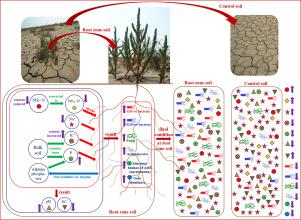Applied Soil Ecology ( IF 4.8 ) Pub Date : 2021-08-17 , DOI: 10.1016/j.apsoil.2021.104196 Aditya P. Rathore 1, 2 , Doongar R. Chaudhary 1, 2 , Bhavanath Jha 1

|
Global climate change and human interference gradually increase the salt-affected land; hence the availability of agricultural land is decreasing day by day. Higher salinity severely affects the physical, chemical and biological characteristics of the soil. Various studies investigated the effects of growing crop plants on soil quality but such investigations on halophytic plants in their natural habitat are limited. Salicornia brachiata was selected to assess its effects on the soil quality over temporal and spatial scales because of its highest importance value index among the naturally growing coastal halophytes at the studied sites. The root zone soil of S. brachiata was sampled (six times in one growing period) from six different coastal sites in Gujarat, India. Soil characteristics, microbial community composition (ester linked-fatty acid methyl ester profiling) and genes (16S rRNA, nifH and cbbL) abundance in comparison with control soil (without vegetation) were studied. The root zone soil of S. brachiata had significantly higher pH, K+ and P, and lower EC, NO3–-N, NH4+-N and Na+ contents than control soil. The contents of total, GM+ve, GM−ve, total bacterial, fungal and actinomycetes FAMEs (fatty acid methyl esters) were higher in the S. brachiata covered soils (37.98, 6.44, 10.38, 16.35, 1.74 and 2.12 nmol g−1, respectively) than control soils (22.22, 3.81, 5.47, 9.30, 0.77 and 1.23 nmol g−1, respectively). Among the studied sites, root zone soil from Diu possessed the highest total, bacterial (GM+ve and GM−ve), fungal and actinomycetes FAMEs, whereas the Vivaniya site exhibited the lowest. Among the sampling periods, S. brachiata soil exhibited significantly elevated contents of total FAME and FAME biomarkers of microbial taxonomic groups in the initial two sampling months (August and October), followed by December and the least in June. Compared with control soil, S. brachiata covered soil possessed the microbial community shift related to the enhanced abundance of total bacterial, GM−ve and fungal FAMEs. The abundance of 16S rRNA, cbbL and nifH genes was higher in S. brachiata covered soils (1.64 × 109, 5.06 × 106 and 2.53 × 107, respectively) compared with control soil (6.78 × 108, 1.55 × 106 and 6.99 × 106, respectively). In the August and October months, the abundance of all three genes was highest in S. brachiata and control soils. The findings of this study confirm the significant effects of S. brachiata on saline soil properties (soil characteristics, microbial activities and genes abundance) over temporal and spatial scales. The results strongly suggest the potentials of S. brachiata for the restoration of salt-affected degraded lands for healthy ecosystem functioning.
中文翻译:

评估 Salicornia brachiata Roxb 的影响。时空尺度上沿海盐渍土质量的增长
全球气候变化和人为干扰逐渐增加受盐分影响的土地;因此,可供使用的农业用地日益减少。较高的盐度严重影响土壤的物理、化学和生物特性。各种研究调查了种植作物对土壤质量的影响,但对自然栖息地中盐生植物的此类调查是有限的。选择Salicornia brachiata来评估其在时空尺度上对土壤质量的影响,因为它在研究地点自然生长的沿海盐生植物中的重要性指数最高。S. brachiata根区土壤从印度古吉拉特邦的六个不同沿海地点采样(在一个生长期内六次)。与对照土壤(无植被)相比,研究了土壤特征、微生物群落组成(酯连接脂肪酸甲酯分析)和基因(16S rRNA、nifH和cbbL)丰度。S. brachiata根区土壤的pH、K +和P显着高于对照土壤,EC、NO 3 – -N、NH 4 + -N 和Na +含量显着低于对照土壤。S. brachiata中总的、GM+ve、GM-ve、总细菌、真菌和放线菌 FAME(脂肪酸甲酯)的含量较高覆盖土壤(分别为 37.98、6.44、10.38、16.35、1.74 和 2.12 nmol g -1)比对照土壤(分别为22.22、3.81、5.47、9.30、0.77和 1.23 nmol g -1)。在所研究的地点中,来自 Diu 的根区土壤拥有最高的总细菌(GM+ve 和 GM-ve)、真菌和放线菌 FAME,而 Vivaniya 地点表现出最低。在采样期间,S. brachiata土壤在最初的两个采样月(8 月和 10 月)表现出微生物分类群 FAME 和 FAME 生物标志物的含量显着升高,其次是 12 月,6 月最低。与对照土壤相比,S. brachiata覆盖的土壤具有与总细菌、GM-ve 和真菌 FAME 丰度增加相关的微生物群落转变。与对照土壤(6.78 × 10 8、1.55 × 10 6)相比,S. brachiata覆盖的土壤(分别为 1.64 × 10 9、5.06 × 10 6和 2.53 × 10 7)中 16S rRNA、cbbL和nifH基因的丰度更高和 6.99 × 10 6)。在 8 月和 10 月,所有三个基因的丰度在S. brachiata和对照土壤中最高。本研究的结果证实了S. brachiata盐渍土特性(土壤特征、微生物活动和基因丰度)在时间和空间尺度上的研究。结果强烈表明S. brachiata在恢复受盐影响的退化土地以实现健康生态系统功能方面的潜力。











































 京公网安备 11010802027423号
京公网安备 11010802027423号